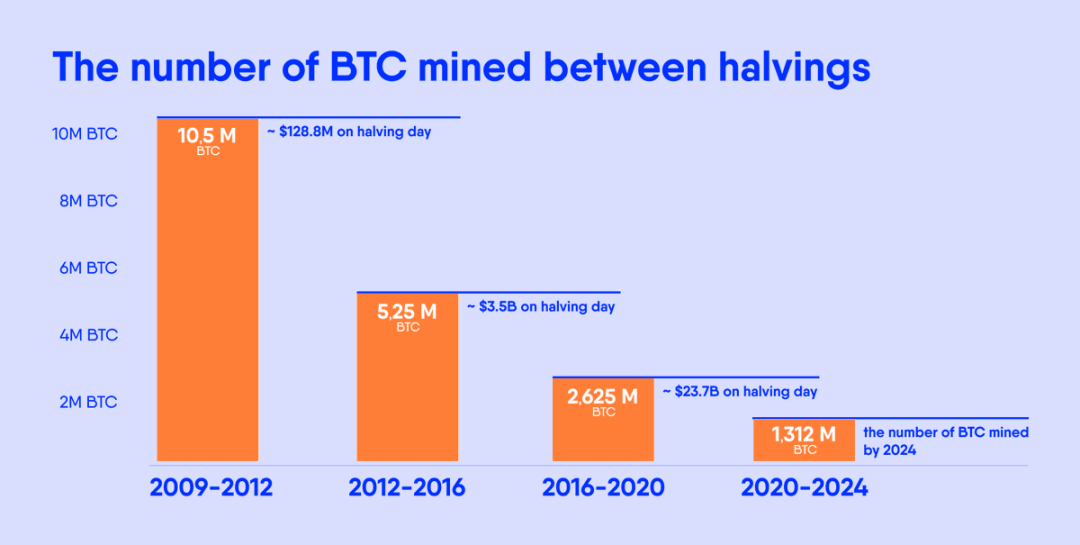Original article by Miles Deutscher
Original translation: TechFlow
The 4-year cycle is over. We are entering a new paradigm in cryptocurrencies where only the fittest survive and the unfit are eliminated.
Here is my strategy for how to navigate market changes in 2025 so I can continue to build wealth in uncharted territory.
Before I share my strategy, let’s first explore why the 4-year cycle is a thing of the past.
There are two reasons why I think the 4-year cycle no longer applies.
1. Halving effect weakens
First, from the supply side, the effect of Bitcoin ($BTC) halving is gradually weakening.
With each halving, the reduction in the issuance of new Bitcoins is getting smaller.

For example, the halvings in 2012 and 2016 reduced issuance by 50% and 25% respectively, so the impact on market prices was very significant.
But by 2024, the halving will only reduce the issuance by 6.25%, which means that the halving has less impact on prices than before.
2. ETFs change the rules of the market
Secondly, from the demand side, the launch of the Bitcoin ETF is a major variable that permanently changes the market rules.
A Bitcoin ETF is a financial instrument that allows investors in traditional financial markets to indirectly invest in Bitcoin.
Since their launch, they have become the most successful ETF products in history, with demand far exceeding expectations.

This influx of demand not only changed the overall landscape of the crypto market, but also broke many old market rules (such as the 4-year cycle).
The biggest impact of ETFs is actually in the altcoin market. Let me explain in detail.
In the past, you may have often seen a chart showing the price rotation relationship between Bitcoin and altcoins. This is indeed true in 2021.
But now, that relationship has expired.

Original image from Miles Deutscher, compiled by TechFlow
Bitcoin’s wealth effect disappears
In 2017 and 2021, when Bitcoin prices rose, many wealthy Bitcoin whales transferred their profits to altcoins on centralized exchanges (CEXs), driving a boom in the altcoin market.
However, most of the new capital flows now enter the market through Bitcoin ETFs, and these funds are not flowing into the altcoin market.
In other words, the way money flows has fundamentally changed, and altcoins no longer benefit from Bitcoin’s wealth effect.
Retail investors skipped Phase 2 (ETH) and Phase 3 (mainstream coins)
Retail investors flocked directly to high-risk speculative projects on the chain, the so-called on-chain casino games (Pump Fun).
The number of retail investors in this cycle has decreased significantly compared to 2021. This is mainly due to the pressure of the macroeconomic environment and the fact that many people were hit hard by events such as LUNA, FTX, BlockFi and Voyager in the previous cycle.
However, those retail players who remain in the market are skipping over mainstream coins and choosing to look for opportunities on-chain.
You can read my detailed analysis of how this phenomenon is affecting the market here .

If my judgment is correct, that is, the cycle theory is no longer applicable, then what changes will this bring to the future market?
I have bad news and good news to share.
The bad news is: it has become harder to make money lying down. This is a natural sign that the industry is gradually maturing.
In fact, there are more trading opportunities in the market now, but if you still use the strategy of 2021 - such as holding a bunch of altcoins and waiting for the arrival of altcoin season - then you may be disappointed or even perform poorly.
The good news is that since there is no so-called four-year cycle, this also means that multi-year bear markets caused by crypto-specific factors will no longer occur. Of course, from a macroeconomic perspective, long-term bear markets are still possible, because cryptocurrencies do not operate in isolation and are more closely related to the macroeconomy now than ever before.
The markets risk-on and risk-off periods are more likely to be driven by changes in macroeconomic conditions. These changes usually trigger short-term mini echo-bubbles rather than one-sided rallies that last for several months. The so-called echo bubble refers to a short-term market rebound caused by changes in the macro environment. Although it is smaller in scale, it has similarities with the large bubbles in the past.
In these bubbles, there are a lot of opportunities to make money.
For example, in 2024, we have seen a rotation of different hot topics: November was the meme craze, December was AI concepts, and January was AI agents. There will undoubtedly be new trends emerging in the future.
These are excellent opportunities to make money if you are sharp enough, but they require a slightly different strategy than past cycles.
This brings me to what I’m going to discuss next: my strategy.
I had dinner with @gametheorizing the other day and he made a very insightful point.
Many people are pursuing an ultimate goal: whether it is to increase their portfolio by 5, 10, or 20 times.
But a better strategy is to focus on multiple small bets rather than going all in. By consistently accumulating a series of small wins, this approach can lead to greater returns in the long run.
Therefore, instead of betting everything and hoping that the copycat season will quickly double your assets, it is better to try to accumulate wealth continuously through the compound interest effect of time.
Specifically, you can adopt the following strategy:
Small bet > take profit, bet again > take profit again, repeat.
This is why many of the top traders and thinkers in the crypto space (such as Jordi) used to be professional poker players. They learned from poker how to think about each transaction with probabilistic thinking, evaluate possible outcomes, and not just bet blindly.
My portfolio is currently allocated like this:
50% is invested in high-conviction assets that are optimistic about the long term, and 50% is used for stablecoins and active trading. I will use this part of the funds to look for short-term opportunities in the market and enter and exit flexibly.
In addition, I use stablecoins as a measure of my trading success and failure. Every time I exit a trade, I transfer my profits back to stablecoins, so I can clearly see my earnings.
If your cryptocurrency portfolio is too diversified and you don’t know how to react to the current market changes, last week I shared a guide detailing how to optimize your portfolio based on market changes.
In this article, I emphasized a key point: the importance of setting invalidation criteria for each trade. Just like when you decide to buy a certain cryptocurrency, you need a clear reason to validate your choice. The so-called invalidation refers to the criteria for exiting a trade in a timely manner when market conditions no longer meet your expectations.
I have noticed that many people lack basic risk management awareness when entering a trade and do not set clear exit criteria, which often leads to unnecessary losses.
If there is one piece of advice you want to take now that will significantly increase your future profitability, it is this: develop clear technical or fundamental “invalidation” criteria for each trade. This will not only help you better manage risk, but also improve your overall trading efficiency.
Of course, your level of confidence in a trade and how long you expect to hold it may affect how you set your criteria or triggers for invalidation. But in any case, this does not change the fact that you need to plan ahead. Having a clear exit plan is one of the keys to successful trading.
Although the current market may not completely follow the previous cyclical laws, I am still confident in the future. As long as we maintain the right mindset and strategy, there is still hope for huge growth in 2025.
We are currently in a bear market, but the market trend will eventually change and bring many new opportunities. Until then, your first goal is to survive.
The rewards in the cryptocurrency market often go to those who can persevere through the wild fluctuations. Patience and tenacity are the keys to success in the end, no matter how the market fluctuates.










